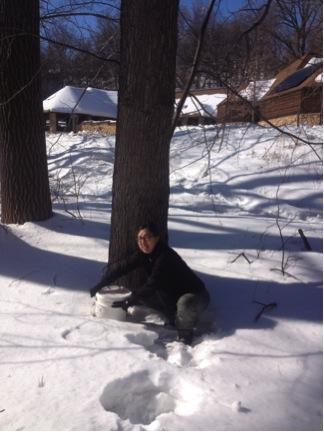*This is the first in a series of periodic posts about enjoying the great outdoors – right here in the Twin Cities metro area. Topics in the series will include parks, trails, hobbies, activities and events. Have a topic you’d like to see covered? Submit your idea by clicking on the “email” button below the post.
Somewhere at the beginning of February, when I’d already had all I could take of this endless and cold, snowy winter, I started daydreaming about new hobbies for spring. Camping, learning to fly fish, and morel hunting topped the list, which brought me to the Department of Natural Resources website. Perusing the list of upcoming events, I happened upon a handful of seminars, including one that especially caught my eye: Maple Syruping in Your Backyard.
With my mom in tow, I attended one of the seminars on a sunny Saturday afternoon at nearby Fort Snelling State Park. This particular event was specifically for women (part of the ongoing Becoming an Outdoors Woman in Minnesota series), with no more than fifteen in attendance – perfect for asking questions and unabashedly having a go with the hand drill.

Fort Snelling State Park Naturalist Krista Jensen demonstrates tapping a silver maple on March 9, 2014.
The seminar lasted less than 2 hours, and Fort Snelling State Park Naturalist Krista Jensen was chock-full of great information, having tapped trees not only in the park, but also on her South Minneapolis property. After covering the history, geography, tools, and statistics of the process, we headed outside to identify and tap a handful of maple trees near the visitor center. Afterward, we visited the outdoor distillation contraption, then sampled the park’s delicious 2013 syrup yield.

The evaporation process is a tricky part of syrup making. Syrup quality (Grade A, B, etc.) is based on the color of the syrup, which is affected by the consistency of heat applied during evaporation. Fort Snelling’s apparatus utilizes wood heat and a specific-gravity system.
Because I’m always eager to try something new, the fact that this can be done right in my backyard, with a single tree, captured my imagination. The percentage of sugar content in maple sap is low (by most accounts less than 4 percent), which means that the sap must be boiled down significantly to become syrup; still, Jensen indicated that when she’d tapped her property’s single sugar maple, she’d ended up with 3.5 gallons of syrup (the end product of approximately 35 gallons of sap).
Interested in making maple syrup at home? The DNR website offers useful information on their site, including instructional videos and a PDF detailing the tools and process, from identifying and tapping trees, to boiling the sap and bottling the syrup.

